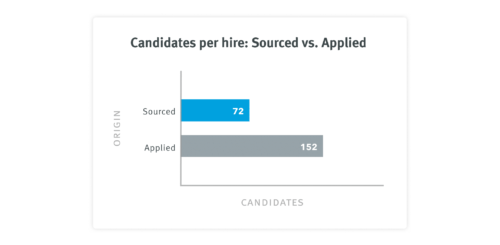3 Recruitment Strategies for Companies Targeting Growth

Growth looks different for every company, and there is no such thing as the “right” recruitment strategy.
Every organization recruits candidates differently since many factors such as industry, geographical location, and company culture affect their efforts. They are also affected by the number of open roles, urgency of the hire, and time of year.
Rather than define a specific path you should follow when trying to attract the best hires and grow your company, we’ve gathered a few creative recruitment strategies that companies have utilized in the past to hire top talent.
Take note of these ideas and consider adding them to your toolbox to grow your firm faster.
1) Be More Strategic With Candidate Sourcing
As talent acquisition professionals, we are well aware that identifying the right candidate sourcing channels can very well be the differentiator when it comes to hiring good talent and reducing employee turnover.
Lever’s Recruiting Benchmarks research found that sourced candidates are more than twice as efficient as candidates applying for open positions at companies.

Source:Lever’s Recruiting Benchmarks Report
There are many channels out there today that you can effectively leverage to source candidates: career fairs, job boards, employee referral programs, networking events, social media, etc.
Most HR managers use a combination of these channels at their companies to build robust talent pipelines that they can tap into when the need arises.
One research study published on ResearchGate studied how to reduce the process lead time from sourcing to onboarding in a Fortune 500 company. The study discovered that adopting a “multi-method approach” for candidate sourcing and using more valid, reliable, and sophisticated selection methods (such as personality questionnaires and cognitive ability tests) helped companies understand the candidate’s personality. It also helped them discover how those candidates fit into the organization.
While a multi-channel sourcing strategy can help talent acquisition leaders bag the best candidates within no time, not all recruitment teams get to work without budget constraints.
A few best practices you can follow to identify the most effective sourcing channels for your company are:
- Always review past success to assess what channels have given you your best hires and consider expanding your use of those channels.
- Ask existing employees for innovative contact ideas. They may be able to guide you toward a conference, university, professional association, or discipline within no time. You can then connect with a fresh pool of candidates.
- Invest in digital outreach through channels including virtual networking events and webinars. Since conducting in-person meetings won’t be feasible due to the ongoing pandemic, such events offer the next best opportunity to source qualified talent strategically.
- Creating a candidate persona can help you identify the right message, channel, and strategy to source more qualified candidates. Once you’ve done that, you can quickly source candidates that best match the traits of your ideal employee.
2) Re-Engage Former Qualified Candidates From Your Talent Pipeline
According to some research, close to 73% of candidates are passive job seekers.
Your recruitment strategy should be targeting candidates that aren’t actively applying for open positions at your company. If you don’t, you’re missing out on many great candidates that may have contributed to the overall success of your organization.
One excellent way of targeting passive candidates is re-engaging former qualified leads by tapping into your existing talent pipeline.
Jacqui Maguire, Director of Talent Acquisition at Greenhouse.io,explains in a recent post how reaching out to former qualified candidates can speed up the process of filling in an open position and save recruiters the hassle of going through each hiring stage:
“We had a departure that left a really important role empty, unexpectedly, at a time when the recruiting team was already at full hiring capacity. So I decided to ask Senior Recruiter Katie DiCioccio if there were any promising candidates from the last time the role was open. I was hoping this would give us a head start—and it did!
This quick search brought up one candidate who really stood out to the hiring manager. Instead of starting from square one, posting the job, and going through the whole process, we reached out to the candidate. We took what normally would have been a three-month search and made it into essentially a one-week process.”
Maguire isn’t the only talent acquisition leader who achieved positive results with this strategy. There are endless such cases often doing the rounds in the recruitment space.
When crafting outreach messages for previously qualified candidates, make sure you spell out that you are aware it may have been some time since you spoke with them last, and ask them if they are still interested in an employment opportunity at your company.
By doing this, you may be able to pique the candidate’s interest again. It is also possible that their positive experience with you might lead to them recommending a qualified friend or colleague who may be interested.
Regardless of whether or not they are actively looking for a job at the time, your odds are still better with warmer candidates than with passive candidate outreach.
3) Leverage Technology to Fill In the Gaps
Lastly, one of the most simple yet effective recruitment strategies out there is combining various state-of-the-art recruitment technology innovations with your day-to-day hiring operations to expand your teams faster.
For one, leveraging automation can help streamline high-level repetitive tasks such as interview scheduling, candidate sourcing, and screening applications using advanced analytical techniques. Using automation leaves more time in recruiters’ hands to engage with candidates on a personal one-to-one basis moving forward.
Artificial Intelligence (AI)-based software solutions such as apps and virtual platforms can help hiring managers reduce the time-to-hire and cost-per-hire.
According to findings of onerecent survey conducted by Thomas.co, most of the respondents said that recruitment software and tools are valuable assets that can help talent acquisition teams understand candidates in a more profound and intelligent way. Tools and software can also help predict success and performance during the hiring process itself rather than waiting to see how things work out once the candidate has been hired.
At Recruiter.com,we’ve helped several established companies such as Amazon, Dentsu,and Ford with our custom AI software solutions and recruiter on-demand services. Innovating and experimenting on the technology front has not only helped us attract competitive talent for our clients, but it has also helped us think about ways they can meaningfully engage and retain candidates in the long run.
Some other tech innovations HR leaders can merge with their daily schedules to scale quickly include:
- Chatbot technology
- Marketing automation
- Video/mobile interviewing channels
- Data analytics
- Predictive analytics
When deciding on which tech-enabled solutions will work best for you, one best practice would be to look at your existing tech stack, hiring budget, what your counterparts are doing, and speak with experts in the tech niche. Then choose accordingly.
To know more about the kind of approach, tools, and best practices you can include within your hiring model to attract the best candidates and achieve growth faster, get in touch with us atRecruiter.com .
We will be happy to help you build your recruitment strategy to achieve a result-oriented and employee-centric workplace in the long run.
Get the top recruiting news and insights delivered to your inbox every week. Sign up for the Recruiter Today newsletter.

